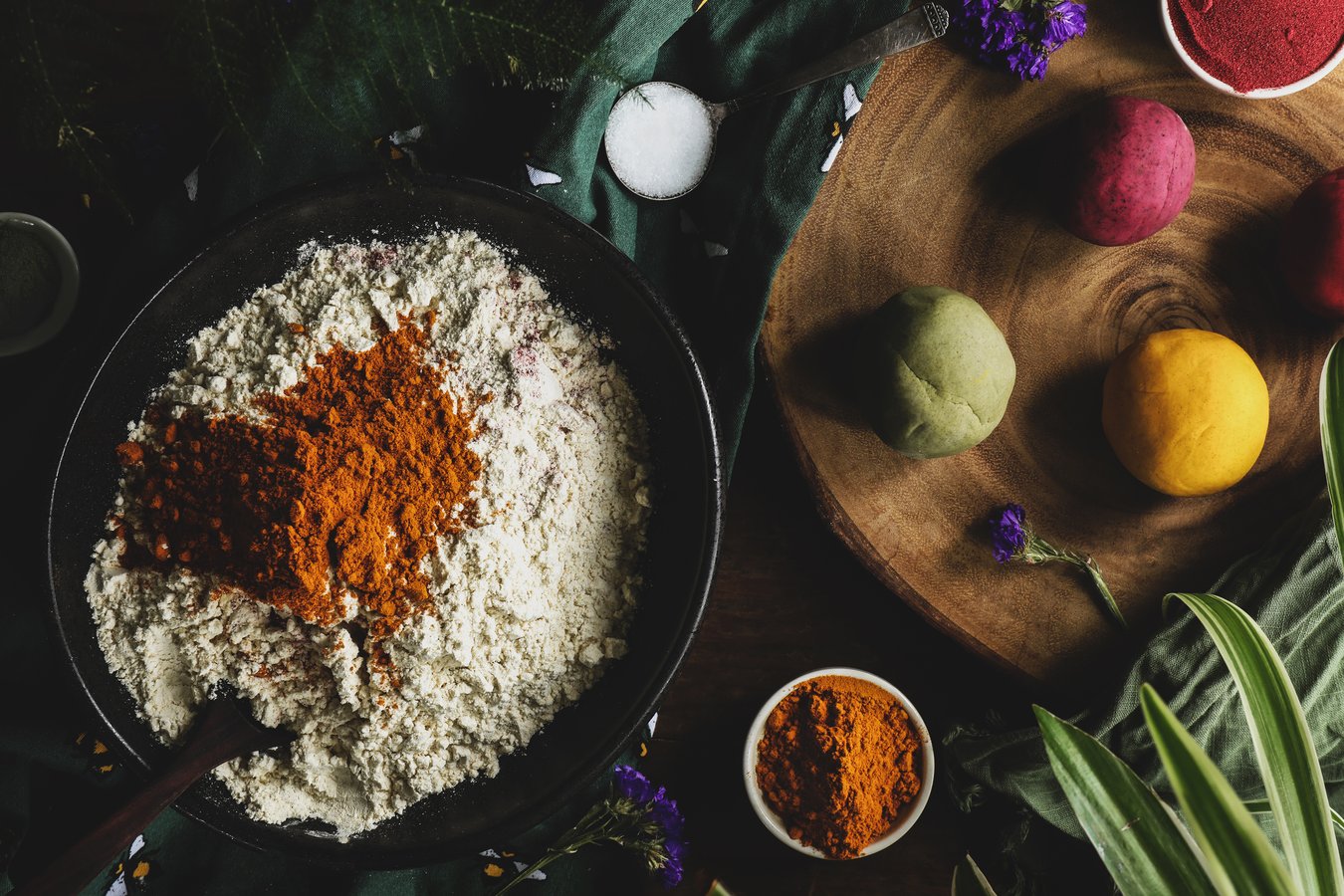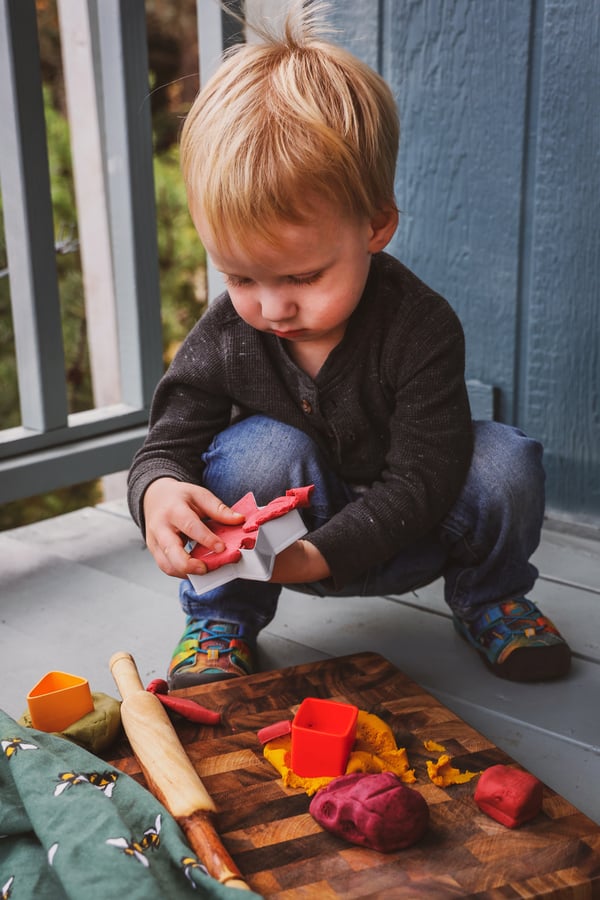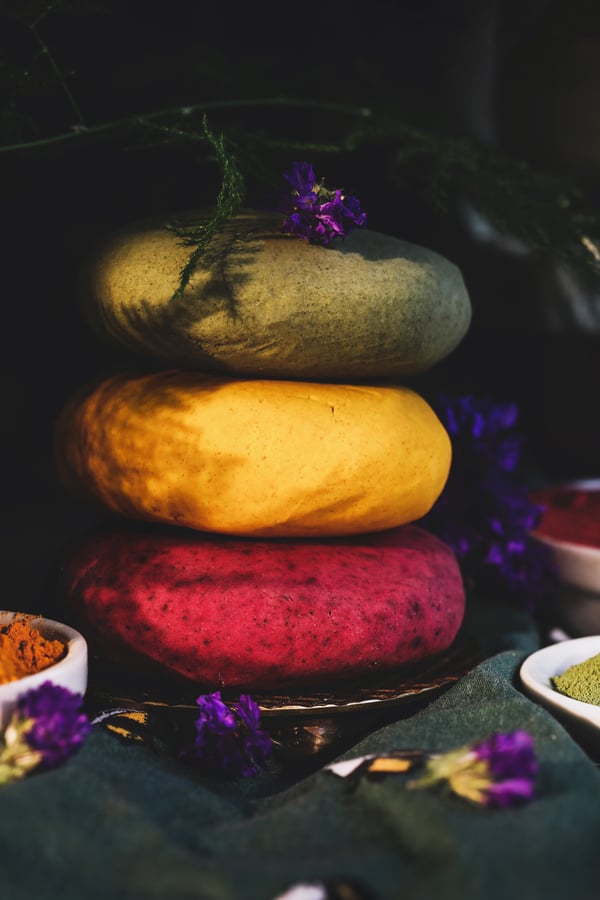Recently, I was barred from calling my grandbaby any endearment that includes the word “baby.” Apparently, we are in “big kid” territory now. The term “big kid” doesn’t really lend itself to sweet endearments, but that aside, the no-longer-baby has had one consistent love since the moment those little hands and big brain were coordinated enough to squish clay—this kid loves playdough. However, Nana (me) is not fond of the typical store-bought versions, which can include chemical preservatives, binders, lubricants, surfactants, hardeners, anti-fungal additives, and artificial fragrances and colors. My favorite little dough-lover spends hours each week rolling, shaping, stamping, and building. I don’t want her hands in chemicals, preservatives, and additives day in and day out. In her world, a day without playdough is a terrible, horrible, no good, very bad day, which means I had to figure out how to make an excellent, naturally colored playdough that is easy to whip up when the need arises.
Flour, salt, cream of tartar, coconut oil, and water—that’s all it takes to make awesome DIY playdough. It’s simple and fast to make, it’s food-safe, and it’s useable within minutes of making it. In an airtight container, it can last for several weeks, longer if you store it in the refrigerator. And you can easily color it with herbal powders rather than artificial food dyes!
Are there risks if your child eats this playdough? The three factors to take into account when kids are playdough eaters are salt content, potassium content and, in this case, choice of herbal powders.
Salt—Whether you buy playdough or make it yourself, it has a lot of salt in it, which isn’t good for any of us. Discouraging children from eating playdough of any kind is a good choice from a salt intake standpoint. However, eating a little salty playdough once in a while isn’t going to make the average child ill.
Potassium—This recipe contains cream of tartar, which gives the dough its wonderfully soft texture and increases shelf life. We all know that cream of tartar is also a culinary ingredient; for instance, it is often used as a stabilizer in meringue. However, cream of tartar is potassium. Potassium is critical to our body’s nerve and muscle functions and occurs naturally in a variety of fruits, vegetables, and other foods. It’s important to note that, just as too little potassium can cause real issues for our health, so can too much. A nibble or two of this playdough is not going to tip that balance in the average child, but if you’ve got a serious dough-eater, you may want to substitute a different acid, like white vinegar or lemon juice. The dough won’t be quite as soft or last as long, but you can always store it in the refrigerator to increase shelf life.
Herbal Powders—To make this dough child-safe, you must only choose powdered herbs that are safe for children to eat. Never choose herbs that are potent medicinals because our skin is very good at absorbing things. Also, children tend to put their hands in their mouths/noses/eyes/ears mid-play, so even if they aren’t directly eating the dough, they are likely to get it in their mucus membranes. If you love the color of an herbal powder, research that herb to make sure it is truly safe for your child to have their hands in on a regular basis. Fruit and vegetable powders are excellent choices. For instance, kale powder makes a wonderful grass-green, turmeric makes a popping yellow, beet root makes a ruby red, cranberry makes pink, cacao makes brown, etc. If you can safely eat it, you can safely color playdough with it.
Here are some wonderful organic, food-safe herbal powder options to get you started on coloring homemade playdough:
Reds and Pinks
Oranges and Yellows
Greens
Kale, Spinach, Nettle Leaf, Rosemary Leaf, Spirulina
Blues and Purples
BrownS
Any odor to this playdough is very subtle; mostly it smells like flour. If you want to add a little more natural aroma, play with culinary extracts like almond extract, vanilla extract, coconut extract, etc. We have found almond extract to be a favorite with the “big kid” set in our family. These aromas do fade with time and use, but you can add a little more later and re-knead the dough.
Homemade Playdough Recipe
Makes about 5 oz.
The best way I’ve found to make multiple colors of playdough in one session is to set out individual bowls of the premixed dry ingredients, each with a different color herbal powder. Set some water on to boil. Then it’s easy to make a production line. Once you’re set up, it takes about ten minutes per bowl to complete, including the kneading.
Ingredients
- 1/2 cup all purpose flour + more as needed
- 2 Tbsp. fine sea salt
- 1 1/2 tsp. cream of tartar
- 2-4 tsp. organic herbal powders of choice, or more as necessary to achieve color
- 1 1/2 tsp. melted organic coconut oil
- About 1/3 cup boiling water
- 1/4-1/2 tsp. culinary extract to add subtle aroma (optional)—we like almond extract
- Organic arrowroot powder for finishing (optional)
Directions
- In a bowl, thoroughly whisk together the flour, salt, cream of tartar, and herbal powder of choice.
- Drizzle in the coconut oil and whisk to incorporate. It will be in little lumps throughout the dry mix.
- Pour in boiling water. Using a rubber spatula, combine ingredients. This is when you'll see the color come out and can add a little more herbal powder if you want a darker hue.
- Dough will be shaggy and may be a little sticky, but should come together easily. Use the spatula to continue moving and folding dough in on itself to incorporate the last of the flour. Once incorporated, if dough is too dry, add more boiling water 1 Tbsp. at a time until dough achieves better consistency. If dough is too wet, you can knead in more flour in the final step.
- Add optional extract for aroma and work into dough with rubber spatula.
- Dump warm dough out on a lightly floured counter, board, or parchment. Knead to incorporate a little more flour and create a soft, smooth dough. Knead and add flour until warm dough feels smooth and good in your hands. It may be a tiny bit sticky still.
- To finish dough, I find kneading in a little arrowroot powder gives a perfect consistency and takes away any final stickiness. Continue kneading for a couple more minutes to fully incorporate dough ingredients and improve texture.
- Put into an airtight plastic or glass container, or a sealed ziplock style baggie for storage.
- This dough does not need to be refrigerated if kept well sealed in a cool place between playtimes—unrefrigerated dough, stored correctly, is shelf stable for about one month. Refrigeration will increase shelf life significantly. Dough should be discarded and composted when it begins to change texture or smell off.
Pro Tips
- If you want a larger batch of a single color, this recipe scales up easily. I find that working with as much as two cups of flour at a time is still easy for adult-size hands, but a little trickier for kids.
- If a playdough-lover needs to steer clear of gluten, you can make this recipe with a one-to-one style gluten-free flour. Different brands produce different results, so you may need to experiment to achieve the best texture.
- Some people use essential oils to add stronger aroma to playdough, but I have a personal “absolutely not" rule about using essential oils with babies and toddlers, hence the culinary extracts in this recipe.
- If playdough starts to dry out with time and use, but doesn’t smell like it’s going off, you can often revitalize it by very lightly dampening a rag and wrapping it around the dough. Put the dough and rag in a ziplock and let them sit for a couple hours then re-knead the dough. Repeat if necessary.
DIY Playdough Recipe Without Cream of Tartar
To substitute for the cream of tartar in homemade playdough, you will need to use 1 tsp. white vinegar or lemon juice for every 1/2 tsp. cream of tartar.
Ingredients
- 1/2 cup all purpose flour + more as needed
- 2 Tbsp. fine sea salt
- 2-3 tsp. organic herbal powders of choice, or more as necessary to achieve color
- 1 1/2 tsp. melted organic coconut oil
- 1 Tbsp. organic white vinegar or lemon juice
- About 1/3 cup boiling water
- 1/4-1/2 tsp. culinary extract to add subtle aroma (optional)—we like almond extract
- Organic arrowroot powder for finishing (optional)
Directions
- Thoroughly whisk together the flour, salt, and herbal powder of choice in a bowl.
- Drizzle in the coconut oil along with 1 Tbsp. white vinegar or lemon juice. Whisk to incorporate. It will be in little lumps throughout the dry mix.
- Follow directions 3-7 in Homemade Playdough Recipe above. You may have to knead in more flour and arrowroot powder due to the extra liquid.
- I suggest refrigerating this dough.
Pro Tip: The vinegar or lemon juice does change the smell of this dough. Both the arrowroot powder and adding an extract can help.
Want more kid-friendly activities?
Try These Herbal Holiday Crafts for Kids!
You may also enjoy:
- Natural Sensory Play for Children: Hearing
- Homemade Organic Baby Food Recipes with Herbs & Spices
- Homemade Mama & Baby Massage Oil Recipe














